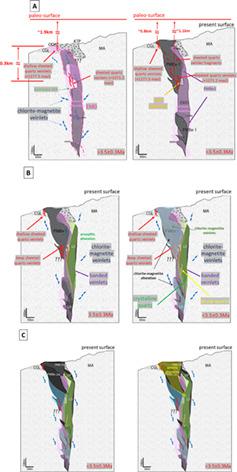当前位置:
X-MOL 学术
›
Resour. Geol.
›
论文详情
Our official English website, www.x-mol.net, welcomes your
feedback! (Note: you will need to create a separate account there.)
Overprinting porphyry‐type veinlets on the intrusive rocks and phreatomagmatic breccias in the Southwest prospect, southwestern Sto. Tomas II (Philex), Baguio District, Philippines
Resource Geology ( IF 1.1 ) Pub Date : 2020-10-13 , DOI: 10.1111/rge.12242 Avriel Venis L. Cirineo 1 , Akira Imai 2 , Ryohei Takahashi 1 , Redempta P. Baluda 3 , Noel C. Oliveros 3 , Victor B. Maglambayan 3 , Roy Ronald C. Luis 3 , Maria Lourdes M. Faustino 3 , Jacky Almadin 3
Resource Geology ( IF 1.1 ) Pub Date : 2020-10-13 , DOI: 10.1111/rge.12242 Avriel Venis L. Cirineo 1 , Akira Imai 2 , Ryohei Takahashi 1 , Redempta P. Baluda 3 , Noel C. Oliveros 3 , Victor B. Maglambayan 3 , Roy Ronald C. Luis 3 , Maria Lourdes M. Faustino 3 , Jacky Almadin 3
Affiliation

|
The Southwest prospect is located at the southwestern periphery of the Sto. Tomas II porphyry copper–gold deposit in the Baguio District, northwestern Luzon, Philippines. The Southwest prospect hosts a copper‐gold mineralization related to a complex of porphyry intrusions, breccia facies, and overlapping porphyry‐type veinlets emplaced within the basement Pugo metavolcanics rocks and conglomerates of the Zigzag Formation. The occurrences of porphyry‐type veinlets and potassic alteration hosted in the complex are thought to be indications of the presence of blind porphyry deposits within the Sto. Tomas II vicinity. The complex is composed of at least four broadly mineralogically similar dioritic intrusive rocks that vary in texture and alteration type and intensity. These intrusions were accompanied with at least five breccia facies that were formed by the explosive brecciation, induced by the magmatic–hydrothermal processes and phreatomagmatic activities during the emplacement of the various intrusions. Hydrothermal alteration assemblages consisting of potassic, chlorite–magnetite, propylitic and sericite–chlorite alteration, and contemporaneous veinlet types were developed on the host rocks. Elevated copper and gold grades correspond to (a) chalcopyrite–bornite assemblage in the potassic alteration in the syn‐mineralization early‐mineralization diorite (EMD) and contemporaneous veinlets and (b) chalcopyrite‐rich mineralization associated with the chalcopyrite–magnetite–chlorite–actinolite±sericite veinlets contemporaneous with the chlorite–magnetite alteration. Erratic remarkable concentrations of gold were also present in the late‐mineralization Late Diorite (LD). High XMg of calcic amphiboles (>0.60) in the intrusive rocks indicate that the magmas have been oxidizing since the early stages of crystallization, while a gap in the composition of Al between the rim and the cores of the calcic amphiboles in the EMD and LD indicate decompression at some point during the crystallization of these intrusive rocks. Fluid inclusion microthermometry suggests the trapping of immiscible fluids that formed the potassic alteration, associated ore mineralization, and sheeted quartz veinlets. The corresponding formation conditions of the shallower and deeper quartz veinlets were estimated at pressures of 50 and 30 MPa and temperatures of 554 and 436°C at depths of 1.9 and 1.1 km. Temperature data from the chlorite indicate that the chalcopyrite‐rich mineralization associated with the chlorite–magnetite alteration was formed at a much lower temperature (ca. 290°C) than the potassic alteration. Evidence from the vein offsetting matrix suggests multiple intrusions within the EMD, despite the K‐Ar ages of the potassic alteration in EMD and hornblende in the LD of about the same age at 3.5 ± 0.3 Ma. The K‐Ar age of the potassic alteration was likely to be thermally reset as a result of the overprinting hydrothermal alteration. The constrained K‐Ar ages also indicate earlier formed intrusive rocks in the Southwest prospect, possibly coeval to the earliest “dark diorite” intrusion in the Sto. Tomas II deposit. In addition, the range of δ34S of sulfide minerals from +1.8‰ to +5.1‰ in the Southwest prospect closely overlaps with the rest of the porphyry copper and epithermal deposits in the Sto. Tomas II deposit and its vicinity. This indicates that the sulfides may have formed from a homogeneous source of the porphyry copper deposits and epithermal deposits in the Sto. Tomas II orebody and its vicinity. The evidence presented in this work proves that the porphyry copper‐type veinlets and the adjacent potassic alteration in the Southwest prospect are formed earlier and at a shallower level in contrast with the other porphyry deposits in the Baguio District.
中文翻译:

Sto西南西南部侵入岩和相岩浆角砾岩上的斑岩斑纹状叠印。菲律宾碧瑶区Tomas II(Philex)
西南远景位于Sto的西南边缘。位于菲律宾吕宋岛西北部碧瑶区的Tomas II斑岩型铜金矿床。西南远景带有铜金矿化,与复杂的斑岩侵入,角砾岩相和重叠的斑岩型细脉有关,这些斑岩嵌在基底的Pugo超火山岩和Zigzag组砾岩中。复合体中斑岩型小脉的出现和钾的改变被认为是Sto内部斑岩斑岩沉积的迹象。托马斯二世附近。该复合物由至少四个在矿物学上相似的异闪闪岩侵入岩组成,这些岩岩的质地,蚀变类型和强度都不同。这些侵入物伴有至少五个角砾岩相,这些角砾岩相是由爆发岩浆形成而形成的,这些断裂是由于岩浆-水热过程和侵位期间的岩浆活动引起的。在母岩上发育了由钾质,绿泥石-磁铁矿,丙炔和绢云母-亚氯酸盐蚀变组成的热液蚀变组合,以及同时期的小脉类型。升高的铜和金品位对应于(a)同步矿化早期矿化闪长闪长岩(EMD)和同期矿脉中钾质蚀变中的黄铜矿-斑脱石组合,以及(b)与黄铜矿-磁铁矿-绿泥石相关的富含黄铜矿的矿化。阳起石±绢云母小脉与亚氯酸盐-磁铁矿蚀变同时发生。矿化后期的晚霞红石(LD)中也存在异常浓度的金。高X镁侵入岩中钙闪石(> 0.60)的变化表明岩浆自结晶初期就开始被氧化,而EMD和LD中钙闪石的边缘与岩心之间的Al成分间隙表明减压在这些侵入性岩石的结晶过程中的某个时刻。流体包裹体热计量法表明,形成了钾质蚀变,相关的矿石矿化和薄片状石英小脉的不混溶流体被捕集。在1.9和1.1 km的深度下,在50和30 MPa的压力以及554和436°C的温度下,估计了较浅和较深的石英细脉的相应形成条件。来自亚氯酸盐的温度数据表明,与亚氯酸盐-磁铁矿蚀变有关的富含黄铜矿的矿化是在比钾质蚀变低得多的温度下(约290°C)形成的。来自静脉偏移矩阵的证据表明,尽管EMD钾离子变化的K-Ar年龄和LD中角闪石的K-Ar年龄在3.5±0.3 Ma左右,但仍存在于EMD内。由于叠印的热液蚀变,钾质蚀变的K-Ar年龄可能被热复位。受约束的K-Ar年龄还表明西南地区较早形成的侵入岩,可能与Sto最早的“暗闪长岩”侵入相吻合。Tomas II存款。另外,δ的范围 来自静脉偏移矩阵的证据表明,尽管EMD钾离子改变的K-Ar年龄和LD中角闪石的K-Ar年龄在3.5±0.3 Ma左右,但仍存在于EMD内。由于叠印的热液蚀变,钾质蚀变的K-Ar年龄可能被热复位。受约束的K-Ar年龄还表明西南地区较早形成的侵入岩,可能与Sto最早的“暗闪长岩”侵入相吻合。Tomas II存款。另外,δ的范围 来自静脉偏移矩阵的证据表明,尽管EMD钾离子改变的K-Ar年龄和LD中角闪石的K-Ar年龄在3.5±0.3 Ma左右,但仍存在于EMD内。由于叠印的热液蚀变,钾质蚀变的K-Ar年龄可能被热复位。受约束的K-Ar年龄还表明西南地区较早形成的侵入岩,可能与Sto最早的“暗闪长岩”侵入相吻合。Tomas II存款。另外,δ的范围 受约束的K-Ar年龄还表明西南地区较早形成的侵入岩,可能与Sto最早的“暗闪长岩”侵入相吻合。Tomas II存款。另外,δ的范围 受约束的K-Ar年龄还表明西南地区较早形成的侵入岩,可能与Sto最早的“暗闪长岩”侵入相吻合。Tomas II存款。另外,δ的范围西南地区从+ 1.8‰到+ 5.1‰的34 S硫化物矿物与Sto中其余的斑岩铜和超热矿床重叠。Tomas II矿床及其附近。这表明硫化物可能是由Sto中斑岩型铜矿床和超热矿床的均质源形成的。Tomas II矿体及其附近。这项工作提供的证据证明,与碧瑶地区的其他斑岩矿床相比,西南前景的斑岩铜型脉和邻近的钾化蚀变形成得较早,且水平较浅。
更新日期:2020-10-13
中文翻译:

Sto西南西南部侵入岩和相岩浆角砾岩上的斑岩斑纹状叠印。菲律宾碧瑶区Tomas II(Philex)
西南远景位于Sto的西南边缘。位于菲律宾吕宋岛西北部碧瑶区的Tomas II斑岩型铜金矿床。西南远景带有铜金矿化,与复杂的斑岩侵入,角砾岩相和重叠的斑岩型细脉有关,这些斑岩嵌在基底的Pugo超火山岩和Zigzag组砾岩中。复合体中斑岩型小脉的出现和钾的改变被认为是Sto内部斑岩斑岩沉积的迹象。托马斯二世附近。该复合物由至少四个在矿物学上相似的异闪闪岩侵入岩组成,这些岩岩的质地,蚀变类型和强度都不同。这些侵入物伴有至少五个角砾岩相,这些角砾岩相是由爆发岩浆形成而形成的,这些断裂是由于岩浆-水热过程和侵位期间的岩浆活动引起的。在母岩上发育了由钾质,绿泥石-磁铁矿,丙炔和绢云母-亚氯酸盐蚀变组成的热液蚀变组合,以及同时期的小脉类型。升高的铜和金品位对应于(a)同步矿化早期矿化闪长闪长岩(EMD)和同期矿脉中钾质蚀变中的黄铜矿-斑脱石组合,以及(b)与黄铜矿-磁铁矿-绿泥石相关的富含黄铜矿的矿化。阳起石±绢云母小脉与亚氯酸盐-磁铁矿蚀变同时发生。矿化后期的晚霞红石(LD)中也存在异常浓度的金。高X镁侵入岩中钙闪石(> 0.60)的变化表明岩浆自结晶初期就开始被氧化,而EMD和LD中钙闪石的边缘与岩心之间的Al成分间隙表明减压在这些侵入性岩石的结晶过程中的某个时刻。流体包裹体热计量法表明,形成了钾质蚀变,相关的矿石矿化和薄片状石英小脉的不混溶流体被捕集。在1.9和1.1 km的深度下,在50和30 MPa的压力以及554和436°C的温度下,估计了较浅和较深的石英细脉的相应形成条件。来自亚氯酸盐的温度数据表明,与亚氯酸盐-磁铁矿蚀变有关的富含黄铜矿的矿化是在比钾质蚀变低得多的温度下(约290°C)形成的。来自静脉偏移矩阵的证据表明,尽管EMD钾离子变化的K-Ar年龄和LD中角闪石的K-Ar年龄在3.5±0.3 Ma左右,但仍存在于EMD内。由于叠印的热液蚀变,钾质蚀变的K-Ar年龄可能被热复位。受约束的K-Ar年龄还表明西南地区较早形成的侵入岩,可能与Sto最早的“暗闪长岩”侵入相吻合。Tomas II存款。另外,δ的范围 来自静脉偏移矩阵的证据表明,尽管EMD钾离子改变的K-Ar年龄和LD中角闪石的K-Ar年龄在3.5±0.3 Ma左右,但仍存在于EMD内。由于叠印的热液蚀变,钾质蚀变的K-Ar年龄可能被热复位。受约束的K-Ar年龄还表明西南地区较早形成的侵入岩,可能与Sto最早的“暗闪长岩”侵入相吻合。Tomas II存款。另外,δ的范围 来自静脉偏移矩阵的证据表明,尽管EMD钾离子改变的K-Ar年龄和LD中角闪石的K-Ar年龄在3.5±0.3 Ma左右,但仍存在于EMD内。由于叠印的热液蚀变,钾质蚀变的K-Ar年龄可能被热复位。受约束的K-Ar年龄还表明西南地区较早形成的侵入岩,可能与Sto最早的“暗闪长岩”侵入相吻合。Tomas II存款。另外,δ的范围 受约束的K-Ar年龄还表明西南地区较早形成的侵入岩,可能与Sto最早的“暗闪长岩”侵入相吻合。Tomas II存款。另外,δ的范围 受约束的K-Ar年龄还表明西南地区较早形成的侵入岩,可能与Sto最早的“暗闪长岩”侵入相吻合。Tomas II存款。另外,δ的范围西南地区从+ 1.8‰到+ 5.1‰的34 S硫化物矿物与Sto中其余的斑岩铜和超热矿床重叠。Tomas II矿床及其附近。这表明硫化物可能是由Sto中斑岩型铜矿床和超热矿床的均质源形成的。Tomas II矿体及其附近。这项工作提供的证据证明,与碧瑶地区的其他斑岩矿床相比,西南前景的斑岩铜型脉和邻近的钾化蚀变形成得较早,且水平较浅。











































 京公网安备 11010802027423号
京公网安备 11010802027423号